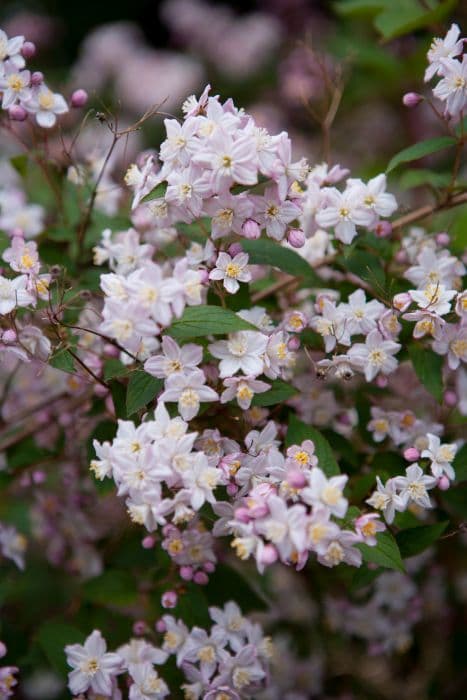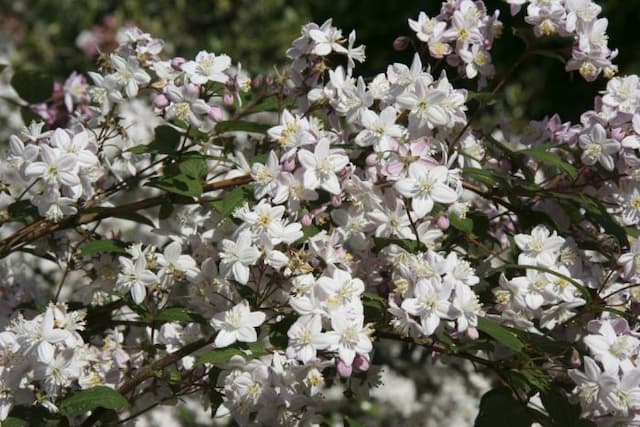Chinese Hydrangea Vine Schizophragma integrifolium

ABOUT
The plant commonly known as the Chinese hydrangea vine is a striking species known for its ornamental appeal. It possesses heart-shaped leaves that are deep green in color. These leaves often show a glossy finish on their surface, contributing to the plant's visual allure. During the blooming season, the Chinese hydrangea vine is adorned with large, flat-topped clusters of creamy-white flowers. These flowers have a unique structure: tiny fertile flowers are found at the center, surrounded by a ring of showy, sterile bracts that resemble petals, giving the blooms a lacey, elegant appearance. These bracts can continue to look attractive on the plant for several weeks. As a climbing plant, it uses aerial rootlets to cling to supports, which can be a wall, trellis, or other sturdy structures. This growth habit allows it to provide a lush, draped effect in the landscape, making it a popular choice for vertical interest in gardens.
About this plant
 Names
NamesFamily
Hydrangeaceae
Synonyms
Chinese Hydrangea Vine, Chinese Climbing Hydrangea
Common names
Schizophragma integrifolium.
 Toxicity
ToxicityTo humans
Schizophragma integrifolium, commonly known as Chinese hydrangea vine, is not widely recognized as a toxic plant to humans. However, it is always prudent to exercise caution and avoid ingesting plants that are not specifically intended for human consumption, as individual reactions can vary and not all effects may be documented.
To pets
There is limited specific information on the toxicity of Schizophragma integrifolium, or Chinese hydrangea vine, to pets such as dogs and cats. While this plant is not commonly listed as toxic, it is advisable to prevent pets from ingesting plants that are not known to be safe, as they might have individual sensitivities or there may be undocumented risks associated with consuming this plant. If you suspect your pet has ingested part of the plant and is showing signs of distress, it's best to consult a veterinarian.
 Characteristics
CharacteristicsLife cycle
Perennials
Foliage type
Deciduous
Color of leaves
Green
Flower color
Cream
Height
30 feet (9.14 meters)
Spread
6 feet (1.83 meters)
Plant type
Climber
Hardiness zones
5
Native area
Asia
Benefits
 General Benefits
General Benefits- Ornamental Appeal: Schizophragma integrifolium, commonly known as False Hydrangea Vine, has attractive foliage and flowers that enhance the aesthetic of gardens and landscapes.
- Climbing Habit: As a climbing plant, it can cover unsightly structures or create vertical interest in garden design.
- Shade Tolerance: It can thrive in shaded areas where other plants might struggle, making it useful for challenging parts of the garden.
- Seasonal Interest: The plant offers seasonal interest with its summertime blooms and autumn leaf color, contributing to year-round garden aesthetics.
- Habitat Support: Its flowers can provide nectar for pollinators, supporting local biodiversity.
- Low Maintenance: Once established, it generally requires minimal care, making it a practical choice for gardeners of all skill levels.
 Medical Properties
Medical PropertiesThis plant is not used for medical purposes.
 Air-purifying Qualities
Air-purifying QualitiesThis plant is not specifically known for air purifying qualities.
 Other Uses
Other Uses- As a natural dye source: Some plants can yield dyes, and Schizophragma integrifolium may potentially be used to create natural dyes for textiles, though specific techniques and colors produced have not been well documented.
- In landscape design as a focal point: Due to its unique flowering and climbing habit, it can be planted as a specimen plant in gardens to create an eye-catching focal point.
- For educational purposes: Horticulture and botany programs may use Schizophragma integrifolium to teach students about climbing mechanisms of plants and plant identification.
- As a butterfly attractant: While not widely known for this purpose, its flowers might attract butterflies and other pollinators, thus promoting biodiversity in a garden setting.
- In theme gardens: Schizophragma integrifolium can be used in Asian-themed gardens to provide authenticity in design, as it is a plant native to Asia.
- As a natural screen: When allowed to grow on fences or trellises, it can provide privacy screening in residential or urban settings.
- For photography and art: The unique aesthetic of the plant's blooms and growth habit can be subjects for photographers and artists who focus on botanical themes.
- In film and theater: Could be used on set to evoke an overgrown, lush or romantic environment in theatrical productions or movie sets.
- Biomimicry inspiration: The climbing nature and leaf structure might inspire designs in biomimicry fields, such as new types of adhesives or architectural structures.
- Green roofing: Potentially could be used in green roofing projects where its climbing tendency allows it to cover surfaces and help regulate building temperatures.
Interesting Facts
 Feng Shui
Feng ShuiThe Chinese Hydrangea Vine is not used in Feng Shui practice.
 Zodiac Sign Compitability
Zodiac Sign CompitabilityThe Chinese Hydrangea Vine is not used in astrology practice.
 Plant Symbolism
Plant Symbolism- Elusiveness – Schizophragma integrifolium, commonly known as the Chinese hydrangea vine, has an elusive character due to its ability to blend and almost disappear against the surfaces it climbs, reflecting the notion of things not always being as they appear.
- Mystery – With its inconspicuous appearance when climbing and the rarity with which it blooms, the Chinese hydrangea vine symbolizes mystery, embracing the unknown and undiscovered.
- Adaptation – As a climbing plant that can adjust to various surfaces and environments, this vine represents adaptability and the ability to thrive in different conditions, much like it adapts to its surroundings in nature.
- Support – The Chinese hydrangea vine relies on structures or other plants for support as it grows, which can symbolize the importance of relationships and leaning on others for growth and stability.
 Water
WaterFor hydrangea vine, water thoroughly to establish the root system in the first few years; hydrangea vine prefers consistently moist but well-drained soil. After establishment, it's more drought tolerant but should be watered deeply once a week during dry periods. Use about 1 to 1.5 gallons of water per plant for each watering session, ensuring that the soil is moistened but not soggy. In the peak of summer, the frequency may increase to twice a week, while in cooler seasons or rainy weather, reduce watering accordingly.
 Light
LightHydrangea vine flourishes best in partial shade to full shade conditions. It is ideal to plant it in a location where it can receive morning light with protection from harsh afternoon sun. The best spot for this plant would be an east-facing garden or under the canopy of large trees where dappled sunlight can filter through.
 Temperature
TemperatureThe optimal temperature range for hydrangea vine is between 60 and 80 degrees Fahrenheit. It can tolerate minimum temperatures down to approximately 20 degrees Fahrenheit, making it suitable for USDA zones 5 through 9. Avoid exposure to extreme heat or cold, as this can stress the plant.
 Pruning
PruningPruning hydrangea vine is important to maintain its size, stimulate healthy growth, and enhance flowering. Prune it in late winter or early spring before new growth begins. Cut back any dead or damaged wood and reduce the size of overgrown stems, aiming to create an even, aesthetically pleasing shape. Annual pruning helps encourage vigorous new growth and bloom production.
 Cleaning
CleaningAs needed
 Soil
SoilThe False Hydrangea prefers a rich, well-draining soil mix with a slightly acidic to neutral pH of about 5.5 to 7. An ideal soil mixture can be created using two parts garden soil, one part peat, and one part perlite to ensure proper drainage and aeration. Regularly amending the soil with organic matter will help maintain its structure and fertility.
 Repotting
RepottingFalse Hydrangea should be repotted every 2-3 years to refresh the soil and accommodate root growth. Younger plants may need repotting more frequently, while mature plants can be repotted less often as their growth rate slows. Ideally, repot in spring or early summer before new growth begins.
 Humidity & Misting
Humidity & MistingFalse Hydrangea thrives in moderate to high humidity levels, typically around 60-80%. In drier environments, humidity can be increased with regular misting, using a humidity tray, or placing a humidifier nearby. Avoid extremely low humidity as it can lead to leaf tip burn or browning.
 Suitable locations
Suitable locationsIndoor
Provide bright indirect light and maintain high humidity.
Outdoor
Plant in partial shade, protect from strong winds, ensure good drainage.
Hardiness zone
5-9 USDA
 Life cycle
Life cycleThe life cycle of Schizophragma integrifolium, commonly known as the Chinese hydrangea vine, starts with seed germination which typically occurs in damp soil in a shaded environment. Seedlings develop into juvenile vines that cling to surfaces with aerial rootlets, slowly growing and establishing a robust root system. As the vine matures, it develops large, heart-shaped leaves and begins to produce clusters of creamy-white flowers surrounded by showy bracts during the summer months. After pollination, the vine sets seed, which may be dispersed by wind or animal activity, allowing for new plants to establish in favorable conditions. The Chinese hydrangea vine is a perennial and will go through a period of dormancy in the winter, with its foliage dying back, before resuming growth in the spring. This cycle of flowering and dormancy repeats annually throughout the plant's life, which can span many years given adequate support and care.
 Propogation
PropogationPropogation time
Spring to early summer
Propogation: For the climbing hydrangea, Schizophragma integrifolium, the most popular method of propagation is through softwood cuttings. This is typically done in late spring or early summer when the plant's new growth is still flexible but has begun to mature. Cuttings should be taken from healthy, non-flowering shoots, each about 4 to 6 inches (10 to 15 centimeters) long, with several leaves. The bottom pair of leaves should be removed and the cut end dipped in rooting hormone before being placed in a well-draining potting mix. The cutting should be kept moist and out of direct sunlight until roots have developed, which can take several weeks. Once rooted, they can be gradually acclimated to outdoor conditions and eventually planted in their permanent location.








![Hydrangea [Early Sensation]](/_next/image?url=https%3A%2F%2Fplants-admin.emdemapps.com%2Fimages%2Fplants%2F%2Fimages%2F604b6150338db.png&w=640&q=75)
